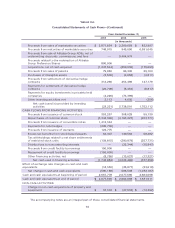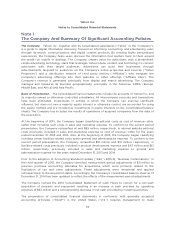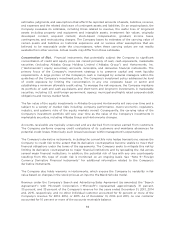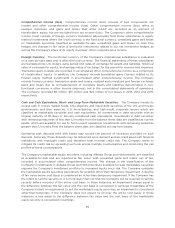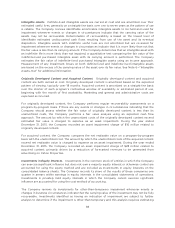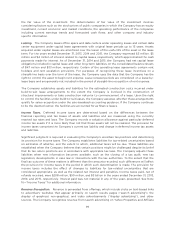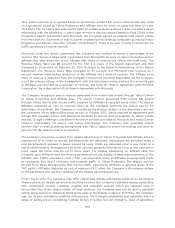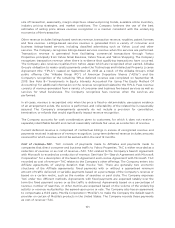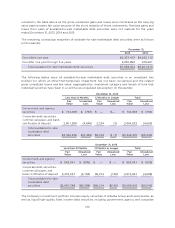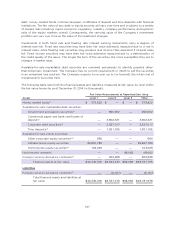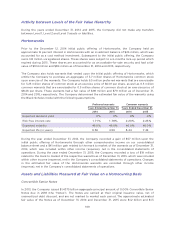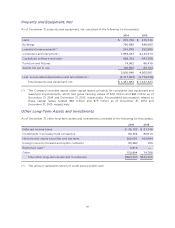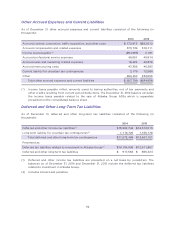Yahoo 2015 Annual Report Download - page 106
Download and view the complete annual report
Please find page 106 of the 2015 Yahoo annual report below. You can navigate through the pages in the report by either clicking on the pages listed below, or by using the keyword search tool below to find specific information within the annual report.Cost of revenue—other. Cost of revenue-other consists of bandwidth costs, stock-based
compensation, content, and other expenses associated with the production and usage of Yahoo
Properties, including expense and amortization of developed technology and patents. Cost of
revenue—other also includes costs for Yahoo’s technology platforms and infrastructure, including
depreciation expense of facilities and other operating costs, directly related to revenue generating
activities.
Amortization of Intangibles. Amortization of customer, affiliate, and advertiser-related relationships
and tradenames, trademarks and domain names are classified within amortization of intangibles.
Amortization of developed technology and patents is included in cost of revenue—other.
Product Development. Product development expenses consist primarily of compensation-related
expenses (including stock-based compensation expense) incurred for research and development, the
development of, enhancements to, and maintenance and operation of Yahoo Properties, advertising
products, technology platforms, and infrastructure. Depreciation expense, third-party technology and
development expense, and other operating costs are also included in product development.
Advertising Costs. Advertising production costs are recorded as expense the first time an
advertisement appears. Costs of advertising are recorded as expense as advertising space or airtime
is used. All other advertising costs are expensed as incurred. Advertising expense totaled
approximately $128 million, $142 million, and $184 million for 2013, 2014, and 2015, respectively.
Restructuring Charges. The Company has developed and implemented restructuring initiatives to
improve efficiencies across the organization, reduce its cost structure, and/or better align its
resources with the Company’s product strategy. As a result of these plans, the Company has
recorded restructuring charges comprised principally of employee severance and associated
termination costs related to the reduction of its workforce, the consolidation of certain real estate
facilities and data centers, losses on subleases, and contract termination costs. The Company’s
restructuring plans include one-time termination benefits as well as certain contractual termination
benefits or employee terminations under ongoing benefit arrangements. One-time termination
benefits are recognized as a liability at estimated fair value when the approved plan of termination
has been communicated to employees, unless employees must provide future service, in which case
the benefits are recognized ratably over the future service period. Ongoing termination benefits
arrangements are recognized as a liability at estimated fair value when the amount of such benefits
becomes estimable and payment is probable. Contract termination costs are recognized at estimated
fair value when the entity terminates the contract in accordance with the contract terms.
These restructuring initiatives require management to make estimates in several areas including:
(i) expenses for severance and other employee separation costs; (ii) realizable values of assets made
redundant, obsolete, or excessive; and (iii) the ability to generate sublease income and to terminate
lease obligations at the estimated amounts.
Stock-Based Compensation Expense. The Company recognizes stock-based compensation
expense, net of an estimated forfeiture rate and therefore only recognizes compensation costs for
those shares expected to vest over the service period of the award. Stock-based awards are valued
based on the grant date fair value of these awards; the Company records stock-based compensation
expense on a straight-line basis over the requisite service period, generally one to four years.
Calculating stock-based compensation expense related to stock options requires the input of highly
subjective assumptions, including the expected term of the stock options, stock price volatility, and
the pre-vesting forfeiture rate of stock awards. The Company estimates the expected life of options
granted based on historical exercise patterns, which the Company believes are representative of
future behavior. The Company estimates the volatility of its common stock on the date of grant
102


